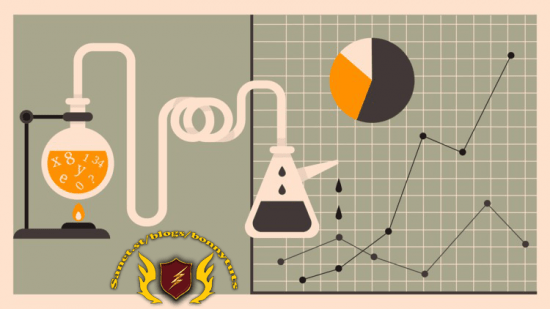你会学到什么
了解数据科学如何将数据转化为有价值的信息。
了解什么是认知偏见,以及数据科学如何帮助我们克服它们。
了解什么是虚假相关性,以及我们如何避免它。
了解如何进行数据驱动的业务实验,以验证变更是否会产生积极的影响。
了解大数据如何带来不可预测的数据收集,以及我们需要如何解决这些问题。
决定使用四种基本数据科学方法中的哪一种。
发现谁是数据科学家,以及成为数据科学家需要什么。
了解数据科学如何通过实验和观察创建科学模型。
记住数据科学的基本方法,比如相关性度量的描述性统计。
获得机器学习模型背后的强烈直觉。
发现为什么数据科学模型简化了人类决策。
MP4 |视频:h264,1280×720 |音频:AAC,44.1 KHz,2 Ch
语言:英语+中英文字幕(云桥网络 机译) |时长:59场讲座(6小时3分钟)|大小解压后:6.06 GB
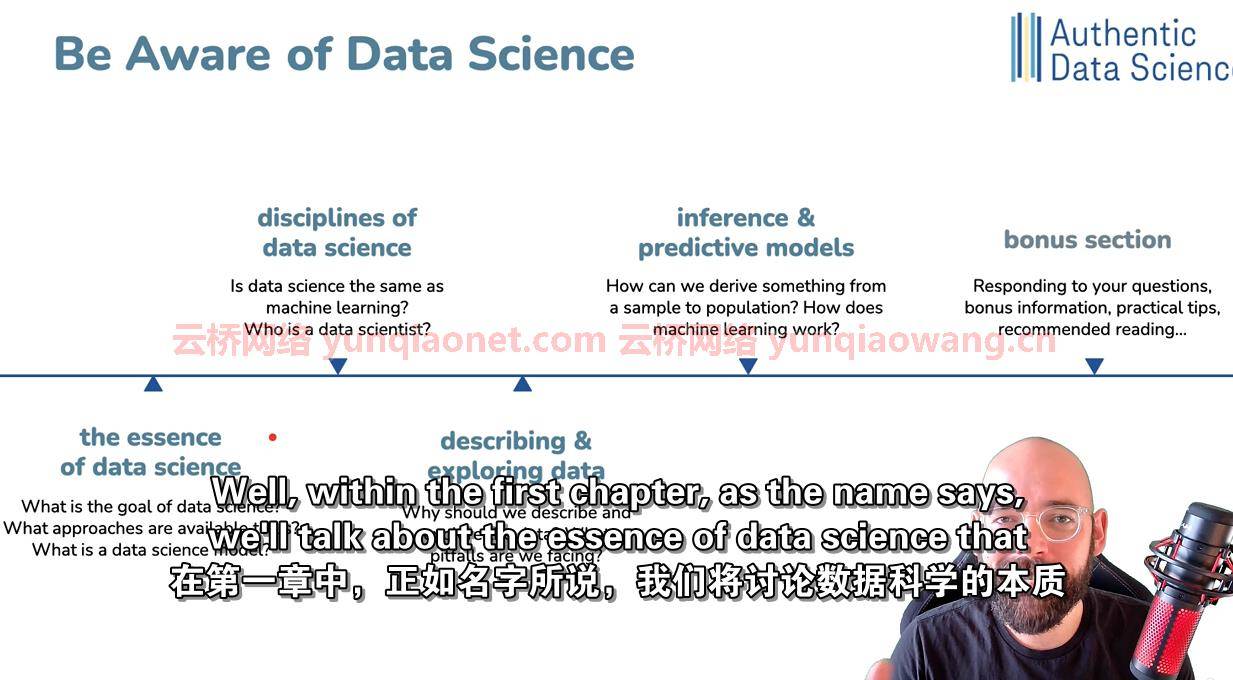
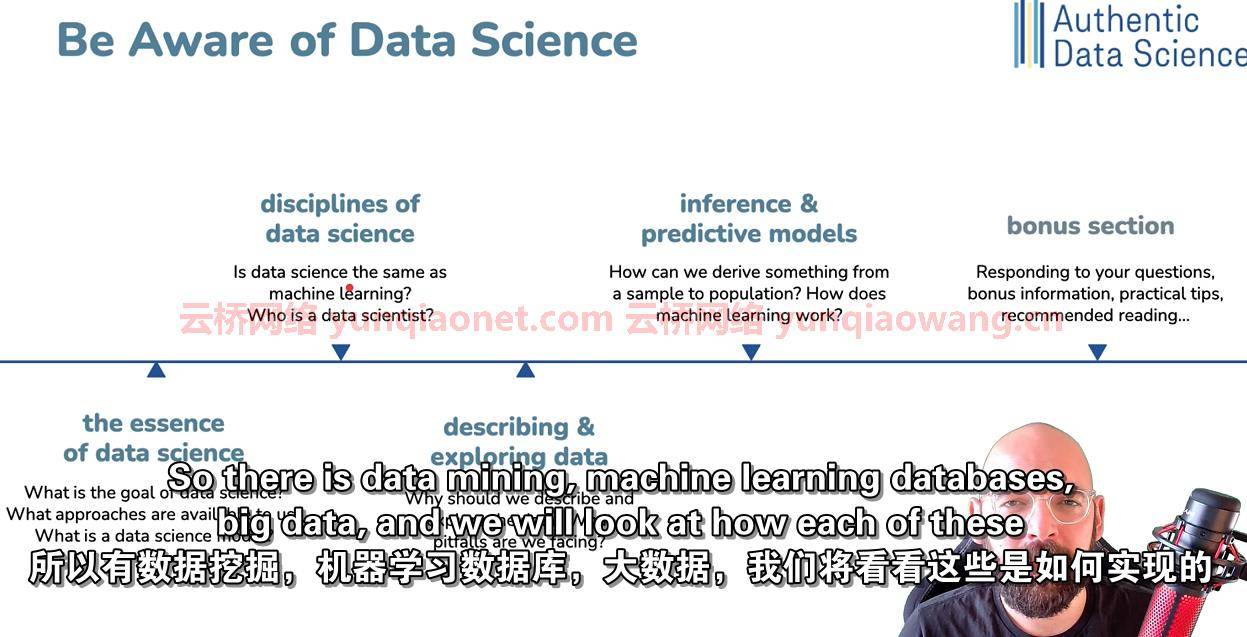
要求
只是学习新概念的动力。这门课程真的是为任何人准备的,即使你是数据科学的绝对初学者。
描述
了解我们如何从数据中获得有价值的信息已经成为日常的期望。以前,组织仰视数据科学家。如今,组织解放了数据科学。每个人都可以为将数据转化为有价值的信息做出贡献。因此,即使你的愿望不是成为一名数据科学家,也要通过获得必要的直观理解,为自己打开这些项目的大门。通过本课程,您可以迈出进入数据科学世界的第一步!本课程将解释数据科学模型如何从绝对的基础上创造价值,即使你觉得自己完全是这个主题的初学者。
三名数据科学家讲授该课程,积累了15年的专业和学术经验。因此,我们不会重复课本。我们将在每一次讲座中发现这一有利可图领域的一个有价值的部分,并带您更接近您未来在数据科学项目中的理想角色。我们不教授该领域的编程方面。相反,我们完全专注于数据科学的概念理解。实践表明,真实世界的项目通过将实践者与透彻、直观的知识结合在一起而受益匪浅。
超过6小时的内容,包括一流的视频讲座、最先进的作业和来自现实世界的直观学习故事。叙述会简单易懂。这门课程将通过几十个相关的例子来启发你,而不是让你厌烦冗长的定义。我们将设身处地地为冰淇淋小贩、研究鹿迁徙的环保主义者、想知道鹳是否会带来婴儿的研究人员等着想!课程结束后,您将了解允许组织将其数据集转化为有价值且可操作的知识的基本原则、方法和方法!
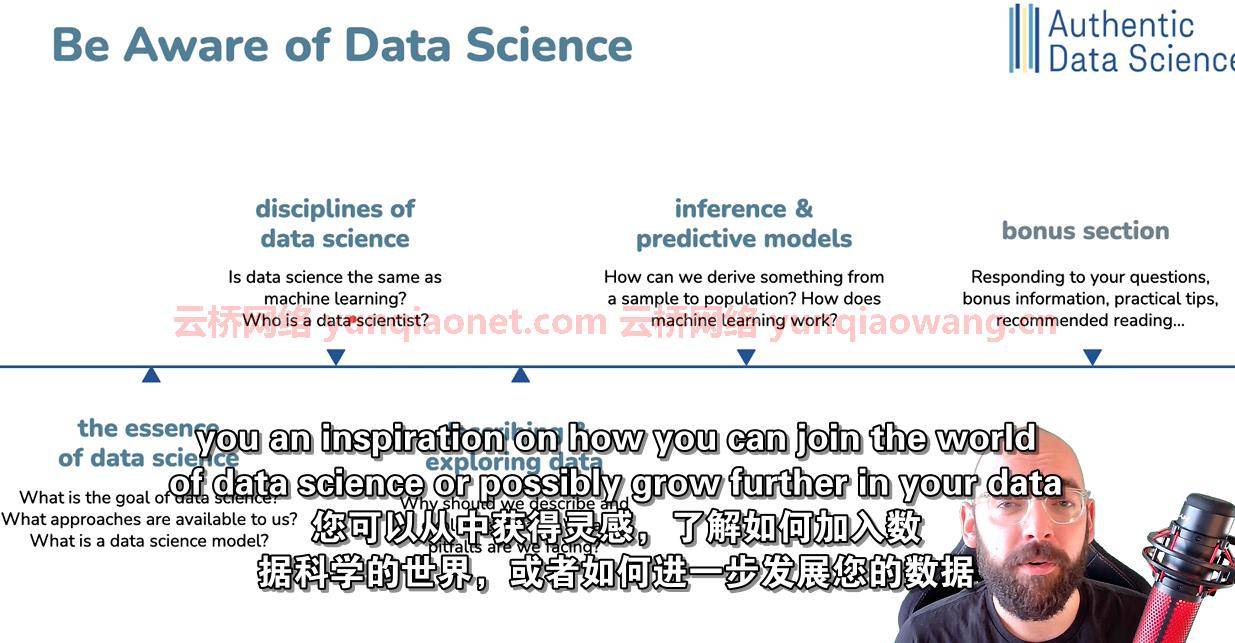
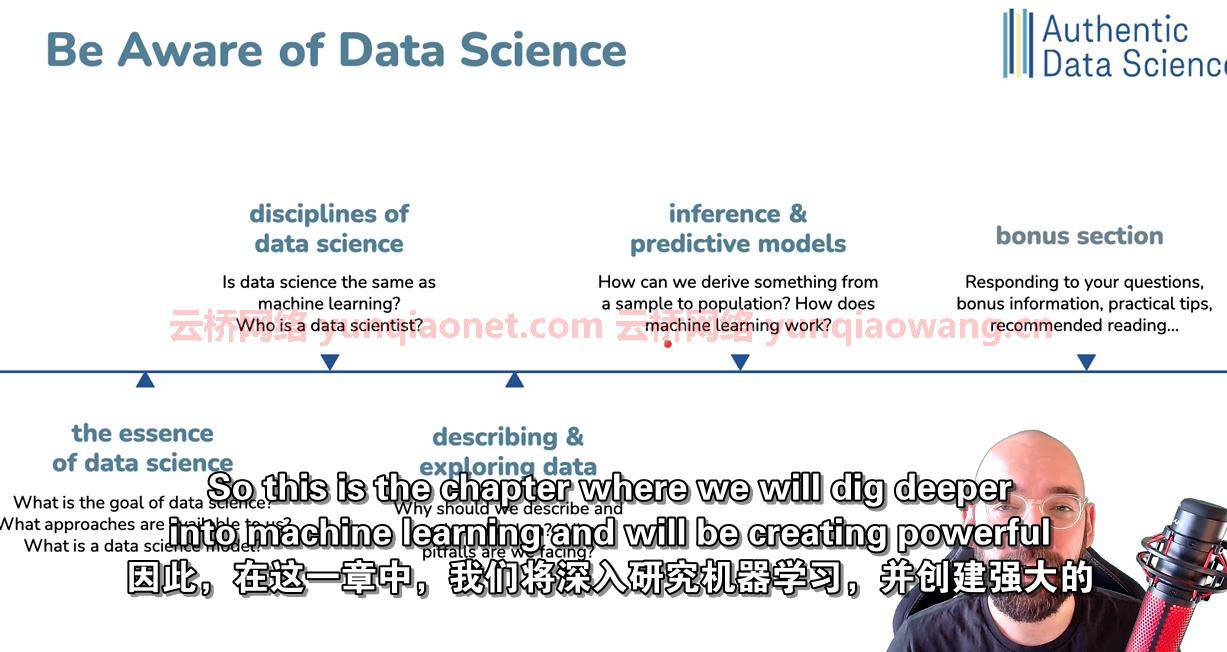
课程结构遵循直观的学习路径!这是章节的大纲和我们将要回答的问题的展示
第一章:“定义数据科学”。我们从多角度定义数据科学开始我们的旅程。为什么数据这么有价值?数据科学的目标是什么?数据科学模型在哪些方面会有偏差?
第二章:“数据科学的学科”。我们继续探索共同创造数据科学的各个学科,如统计学、大数据或机器学习。人工智能和机器学习有什么区别?谁是数据科学家,他/她需要什么技能?为什么数据科学用例显得如此复杂?
第三章:“描述和探索数据”。我们处理描述性和探索性的数据科学方法,并发现这些方法如何创造有价值的信息。什么是相关性,什么时候是虚假的?什么是异常值,为什么它们会影响我们的认知?为什么我们总是要研究传播的尺度?
第4节:“推断和预测模型”。在这里,我们关注推理和预测方法。创建预测模型时,机器学习是我们唯一的选择吗?我们如何使用统计推断来验证新的销售活动是否成功?
第五节:“奖金部分”。我们提供成长为数据科学的个人建议、推荐阅读列表等等!
我们通过易于消费的叙述而不是枯燥的定义带来真实的例子。这些故事涵盖了课程中最重要的学习内容,类似故事的描述将使其更容易记忆和记忆。例子
“鹳会带宝宝吗?”故事将教会我们相关性、因果关系和虚假相关性之间的关键区别。
“我们看到的是狗还是狼?”故事将解释为什么不盲目相信机器学习模型是至关重要的,因为它可能会学习不幸的模式。
“蘑菇可以吃吗?”case将显示一个可能完全失败的项目,仅仅是因为我们使用的有偏见的数据集。
“哪个房子是对的?”story将解释,如果我们想在数据中发现一些复杂、多维的模式,为什么我们经常要依赖机器学习。
“我喜欢黄色随身听!”是20年前的一个案例,当时一家大型制造商正在考虑推出新产品。如果他们依靠人们说的而不是数据说的,他们就会对现实有一个扭曲的看法!
“不要相信河马!”不幸的是,它展示了世界各地许多组织正在发生的事情。人们倾向于相信收入最高的人的意见,而不是相信数据所说的。
课程是互动的!这是你会遇到的
作业中,你可以练习学到的概念,并应用你的创造性和批判性思维。
测验,你可以在上面证明你已经从课程中学到了知识。
你可以带走很多讲义,甚至打印出来供你以后参考!
您可以在日常工作中使用的可共享材料,以传达重要的数据科学信息。
参考和有价值的链接,有价值的材料和强大的数据科学的例子在行动。
重要提醒:本课程不教授该领域的编程方面。相反,它涵盖了概念和业务学习。
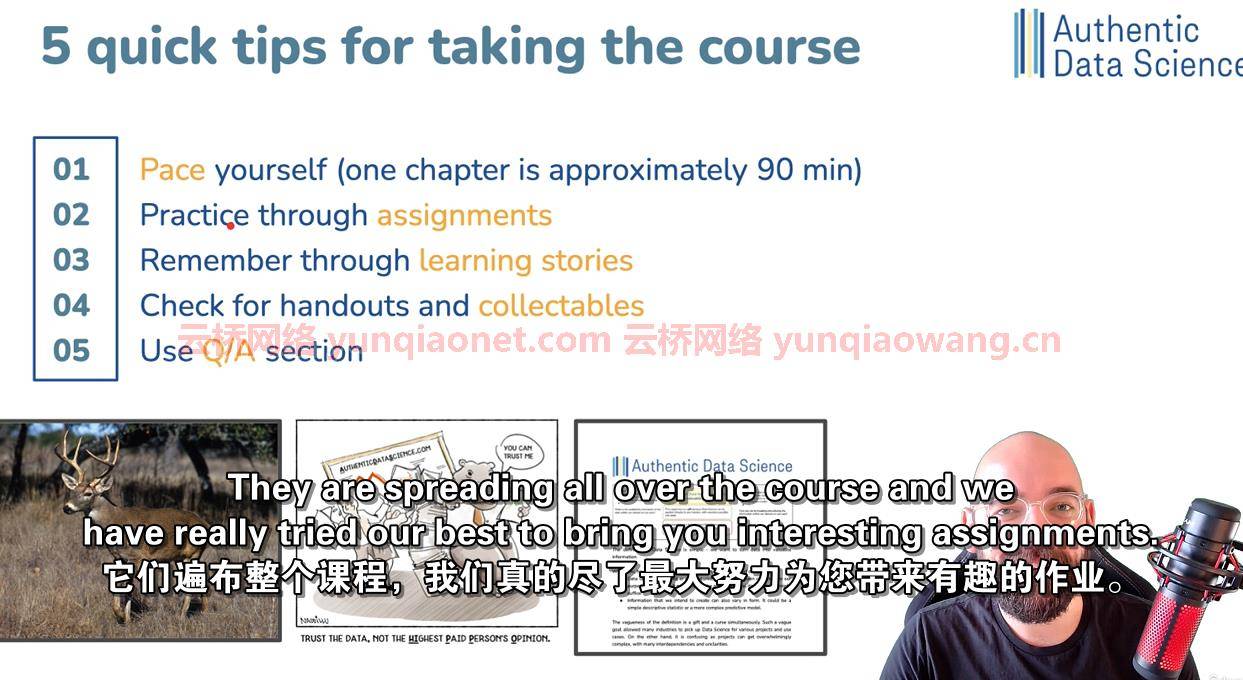
这门课是给谁的
任何对数据科学感兴趣的人。
想从事数据科学职业的大学生。
来自数据相关学科的技术专业人员,他们觉得自己缺乏正规的数据科学教育。
软件工程师、商业智能专家和报告分析师,他们正考虑在职业生涯中转向数据科学。
任何准备去一个处理大量数据的部门面试的人。
任何希望在日常运营中更多地实施数据科学的人。
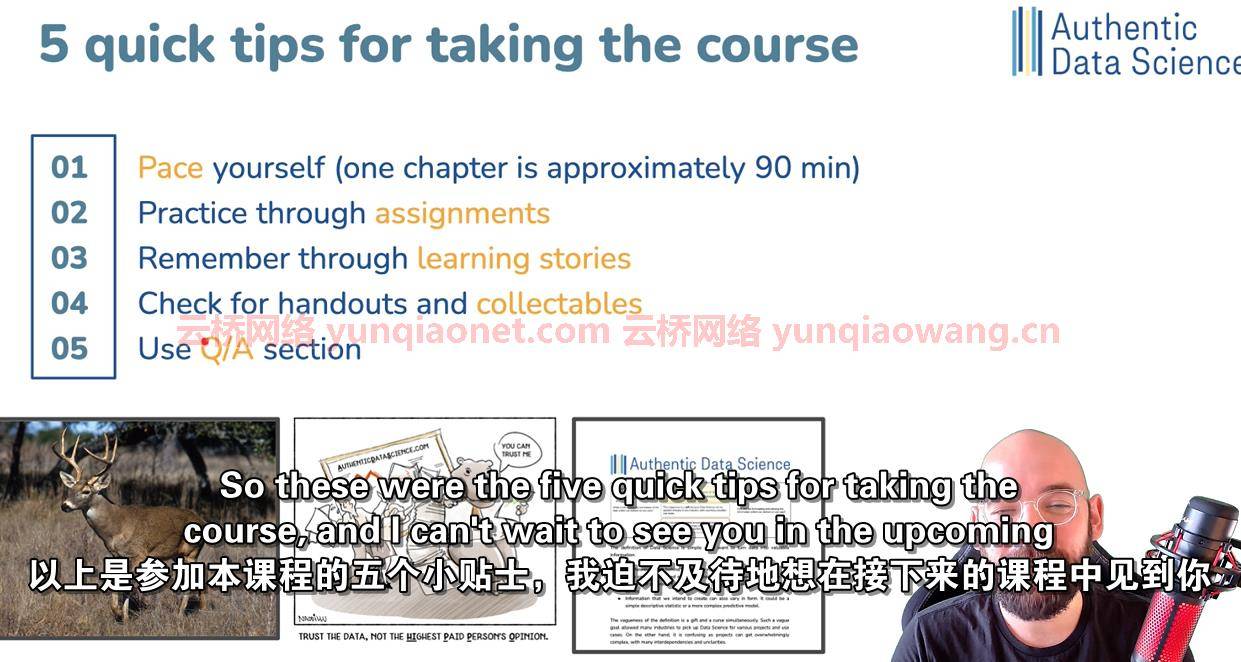
MP4 | Video: h264, 1280×720 | Audio: AAC, 44.1 KHz, 2 Ch
Genre: eLearning | Language: English + srt | Duration: 59 lectures (6h 3m) | Size: 5.67 GB
Take the first step into the world of Data Science with Data Science experts
What you’ll learn
Learn how data science turns data into valuable information.
Understand what cognitive biases are and how data science helps us fight them.
Know what spurious correlation is and how we can avoid it.
Learn how to conduct a data-driven business experiment that verifies whether a change creates a positive impact.
Realize how Big Data brings unpurposed data collections and how we need to address these.
Make decisions about which of the four essential data science approaches to utilize.
Discover who data scientists are and what it would take for you to become one.
Recognize how Data Science creates scientific models through experimentation and observation.
Remember basic methods of data science such as descriptive statistics of correlation measure.
Obtain a strong intuition behind what a Machine Learning model does.
Discover why a data science model simplifies human decision-making.
Requirements
Just a motivation to learn new concepts. This course is really meant for anyone, even if you are an absolute beginner to the topic of Data Science.
Description
Understanding how we can derive valuable information from the data has become an everyday expectation. Previously, organizations looked up to data scientists. Nowadays, organizations liberate data science. Everyone can contribute to the efforts of turning data into valuable information. Thus, even if your aspirations are not to be a data scientist, open yourself the door to these projects by gaining so-necessary intuitive understanding. With this course, you can take the first step into the world of data science! This course will explain how data science models create value from the absolute basics even if you feel like a complete beginner to the topic.
Three data scientists deliver the course, with cumulative 15 years of professional and academic experience. Hence, we won’t repeat the textbooks. We will uncover a valuable bit of this lucrative field with every lecture and take you closer to your desired future role around data science projects. We do not teach programming aspects of the field. Instead, we entirely focus on data science’s conceptual understanding. As practice shows, real-world projects tremendously benefit by incorporating practitioners with thorough, intuitive knowledge.
Over 6 hours of content, consisting of top-notch video lectures, state-of-the-art assignments, and intuitive learning stories from the real world. The narrative will be straightforward to consume. Instead of boring you with lengthy definitions, the course will enlighten you through dozens of relatable examples. We will put ourselves in the shoes of ice cream vendors, environmentalists examining deer migrations, researchers wondering whether storks bring babies, and much more! After the course, you will be aware of the basic principles, approaches, and methods that allow organizations to turn their datasets into valuable and actionable knowledge!
The course structure follows an intuitive learning path! Here is an outline of chapters and a showcase of questions that we will answer
Chapter 1: “Defining data science”. We start our journey by defining data science from multiple perspectives. Why are data so valuable? What is the goal of data science? In which ways can a data science model be biased?
Chapter 2: “Disciplines of Data Science”. We continue by exploring individual disciplines that together create data science – such as statistics, big data, or machine learning. What is the difference between artificial intelligence and machine learning? Who is a data scientist, and what skills does s/he need? Why do data science use cases appear so complex?
Chapter 3: “Describing and exploring data”. We tackle descriptive and exploratory data science approaches and discover how these can create valuable information. What is a correlation, and when is it spurious? What are outliers, and why can they bias our perceptions? Why should we always study measures of spread?
Section 4: “Inference and predictive models”. Herein, we focus on inferential and predictive approaches. Is Machine Learning our only option when creating a predictive model? How can we verify whether a new sales campaign is successful using statistical inference?
Section 5: “Bonus section”. We provide personal tips on growing into data science, recommended reading lists, and more!
We bring real-life examples through easy-to-consume narratives instead of boring definitions. These stories cover the most critical learnings in the course, and the story-like description will make it easier to remember and take away. Example
“Do storks bring babies?” story will teach us a key difference among correlation, causation, and spurious correlation.
“Are we seeing a dog or a wolf?” story will explain why it is crucial to not blindly trust a Machine Learning model as it might learn unfortunate patterns.
“Is the mushroom edible?” case will show a project that might be a complete failure simply because of a biased dataset that we use.
“Which house is the right one?” story will explain why we frequently want to rely on Machine Learning if we want to discover some complex, multi-dimensional patterns in our data.
“I love the yellow walkman!” is a case from 20 years ago, when a large manufacturer was considering launching a new product. If they relied on what people say instead of what data say, they would have a distorted view of reality!
“Don’t trust the HIPPO!” is a showcase of what is, unfortunately, happening in many organizations worldwide. People tend to trust the Highest Paid Person’s Opinion instead of trusting what the data says.
The course is interactive! Here is what you will meet
Assignments in which you can practice the learned concepts and apply your creative and critical thinking.
Quizzes on which you can demonstrate that you have gained the knowledge from the course.
You can take away many handouts and even print them for your future reference!
Shareable materials that you can use in your daily work to convey a vital Data Science message.
Reference and valuable links to valuable materials and powerful examples of Data Science in action.
Important reminder: This course does not teach the programming aspects of the field. Instead, it covers the conceptual and business learnings.
Who this course is for
Anyone interested in data science.
Students at college who want to pursue a career in data science.
Technical professionals from data-related disciplines who feel like they lack formal education in data science.
Software engineers, BI specialists and reporting analysts who are considering a switch in their career towards data science.
Anyone preparing for a job interview to a department that works a lot with the data.
Anyone who would like to implement data science more in their daily operations.
云桥网络 为三维动画制作,游戏开发员、影视特效师等CG艺术家提供视频教程素材资源!
1、登录后,打赏30元成为VIP会员,全站资源免费获取!
2、资源默认为百度网盘链接,请用浏览器打开输入提取码不要有多余空格,如无法获取 请联系微信 yunqiaonet 补发。
3、分卷压缩包资源 需全部下载后解压第一个压缩包即可,下载过程不要强制中断 建议用winrar解压或360解压缩软件解压!
4、云桥网络平台所发布资源仅供用户自学自用,用户需以学习为目的,按需下载,严禁批量采集搬运共享资源等行为,望知悉!!!
5、云桥网络-CG数字艺术学习与资源分享平台,感谢您的赞赏与支持!平台所收取打赏费用仅作为平台服务器租赁及人员维护资金 费用不为素材本身费用,望理解知悉!
6、For users outside China, if Baidu Netdisk is not convenient for downloading files, you can contact WeChat: yunqiaonet to receive a Google Drive download link.


